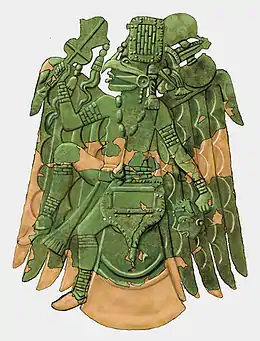John P. Rogan
John P. Rogan was an archaeologist. Working under Cyrus Thomas in the early 1880s, Rogan conducted the first archaeological excavations on the Etowah Indian Mounds, near Cartersville, Georgia, for the Smithsonian Institution.[1][2][3] He discovered a set of copper plates, the Etowah plates, several of which are the famous copper eagle dancer plates, which were later named the Rogan plates (the plates are now Catalogue Nos. A91117 and A91113 in the collections of the Department of Anthropology, National Museum of Natural History, Smithsonian Institution). Rogan tested seven other archaeological sites in Georgia in Bartow, White, Habersham, Forsyth, Rabun, Elbert, and McIntosh counties. He resigned in 1886 to work in the mercantile business in Bristol, Tennessee.[4]

References
- King, Adam (December 2003). "Over a Century of Explorations at Etowah". Journal of Archaeological Research. 11 (4): 279–306. doi:10.1023/A:1026393421806. ISSN 1059-0161.
- "PREHISTORIC RELICS IN THE SOUTH". The New York Times. April 15, 1883. Retrieved 2008-10-11.
- Ward, H. Trawick; R. P. Stephen Davis (1999). Time Before History. University of North Carolina Press. p. 7. ISBN 978-0-8078-4780-0. Retrieved 2008-10-11.
- Cook, M. D. (2011). Bat Creek Stone: At a Glance. Soddy Daisy, TN: POL Publishing.
- Cyrus Thomas: 1894 Report on Mound Explorations in Eastern United States.